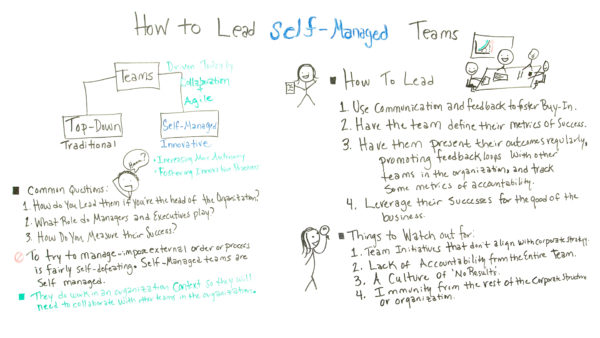Self-managed teams aren’t new, but with Agile methodology and project collaboration on the rise, they’re more prevalent than ever. Jennifer Bridges, PMP, shows you how to lead them.
Here’s a screenshot of the whiteboard for your reference!

In Review – How to Lead Self-Managed Teams
Through self-directed or self-managed teams have been around for a long time, they’re in more common use today, said Jennifer. That rise is driven by the growing presence of Agile teams, team collaboration and online collaborative tools.
Traditionally, teams are managed from the top down. But that won’t work with a self-managed team. They’re more flexible, autonomous and innovative in approach.
Some Common Questions
Leading a self-managed team is different than the old model of team leadership. If you’ve found yourself in such a position, here are some questions you should ask yourself:
- How do you lead them if you’re the head of the operation?
- What role do managers and executives play?
- How do you measure their success?
One thing you should not do is try and impose external order or process on a self-directed team. That will be self-defeating, as by definition self-managed teams are self-managed.
They don’t work in an organized context, and they need to be free to collaborate with other teams in the organization.
How to Lead
You’ve questioned your assumptions and you know what not to do, so now what should you do?
- Communicate: By communicating clearly and seeking feedback, you get buy-in from the team. Use tools that foster collaboration and communication.
- Metrics: Allow the team to define their metrics of success. If they do so, then they’re going to be more accountable for meeting their goals. Software with real-time dashboards can help track metrics.
- Present Outcomes: By having the team present outcomes regularly, you promote feedback loops with other teams in the organization and enforce accountability.
- Leverage Success: Leverage their success for the good of the business.
What to Watch Out For
- Alignment: Be careful to make sure that team initiatives align with corporate strategy.
- Accountability: If anyone on the team is not taking accountability for their actions, that’s a red flag.
- Culture: What sort of culture is developing in the team? If it’s one of “no results,” be careful.
- Immunity: There cannot be immunity from the rest of the corporate structure or organization.
Pro-Tip: Before you can lead them, you have to know how to set up self-directed teams. That means assembling a team that has joint responsibilities, is interdependent, empowered and shares a common goal.
Transcription:
Today, we’re talking about “How to Lead Self-Managed Teams.” Well, self-managed teams or self-directed teams have been around for a very long time, but we’re seeing them more prevalently these days because they’re driven by more collaboration and more collaboration tools and more agile teams and agile methodologies.
So it allows for more innovative ways of working together. It increases more autonomy with the teams. It also fosters innovative practices more so than the traditional top-down structure.
So here are some of the common questions that people have when they go to lead. So, “How do you lead them if you’re the head of the organization?” There are also, “What role do managers and executives play in this setup? And how do you measure their success?”
So, one thing to avoid is to try to manage or impose external processes on a self-directed or self-managed team is really self-defeating because they’re self-managed. They do work in an organization, so they still have to comply with the organization in those organizational structures.
So, how to lead a self-managed team. Number one, use communication and feedback to foster buy-in. The more you communicate and collaborate and ask them for their opinions and let them contribute, then the more they buy-in. And today, there are better software tools that allow for communication and real-time collaboration.
Number two, have the team define their metrics of success. If they define their metrics, then they tend to be more accountable for their success. And again, today with the tools, they can set this up and have insights to those in a real-time basis.
Number three, have them present their outcomes regularly, promoting feedback loops with other teams they have to interact with and track some metrics of accountability.
And number four, leverage their successes for the good of the business.
So here are some things to watch for. Number one, team initiatives that don’t align with the corporate strategy. So if you do find the team is working on those, just work with them to reprioritize so they’re working on the ones that do.
Number two, lack of accountability from the entire team. So if you have an entire that, for some reason, doesn’t feel accountable for their work products or things that they’ve committed to, I would look a little deeper because maybe there’s a lack of clarity around the roles and responsibilities of who is accountable.
Number three, a culture of no results. So if you’re looking at a culture, that’s pretty deep. That’s the behaviors and characteristics of that group. So, either you can work with them or bring someone in, or they can work together to reset the culture of that group. Because if you do have one that is yielding no results, those, typically, get disband.
Number four, immunity from the rest of the corporate structure organization. Because many of these self-managed teams are part of special projects, then they may be working in a different building. They may be working virtually.
So this is just something to keep an eye on. But these are some of the common questions, these are some ways to lead, and then these are some things to watch for.
So if you need a tool that can help you lead your self-managed teams, then sign up for our software now at projectmanager.

